- What to See while Waiting for your Hagia Sophia Tickets
- The Hidden Beauty on the Balcony at the Hagia Sophia in Istanbul
- The Shunned Hidden Crosses in the Hagia Sophia’s Courtyard
- The New Hidden Items in the Hagia Sophia
- A free walking tour around Hagia Sophia
The Hagia Sophia, the jewel of Justinian’s reign, has withstood earthquakes, vandalism, and religious exchange. Even with the covering of Islam, the place reveals the beauty of hidden crosses in the Hagia Sophia’s courtyard. Unfortunately, since the site’s entrance was changed in Jan. 2024, the courtyard is no longer accessible. Let’s see what you are missing.
Many Christian sites in Turkiye reflect a post-Islamic presentation of history by often ignoring the Christian nature of the tourist place. For example, walking upon the ground of the Hagia Sophia represents a location that former churches occupied for close to 1100 years, longer than the time period of a Mosque. However, the mosque label disregards the past by lacking to display any Byzantine history. If you are able to enter the courtyard, here are some ancient clues to discover in the Hagia Sophia’s courtyard. Or it may be possible to look through the walled gate to see some of these items.
Near to Security
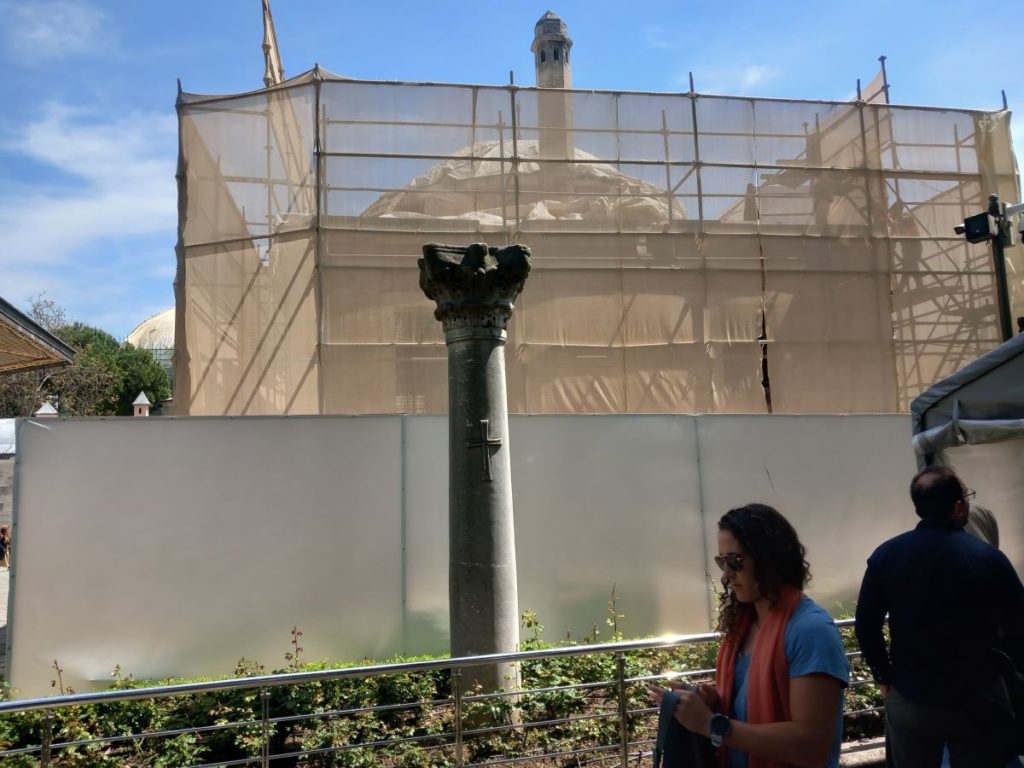
On the southern side, near the security section, a lone column with a cross sits in the garden lot to inform visitors that they have entered an ancient church. Columns meant entrances and public squares, which prepared the worshipers to focus their minds on the cross. Many of these hidden crosses are in the Hagia Sophia’s courtyard.
Typically, Türkiye stores Christian archeology history in open spaces like a museum’s courtyard or garden. Accordingly, after security on the left, two enclosed, non-accessible sections initiate where we will begin our search for understanding the past.
Sacred columns in Hagia Sophia’s Garden
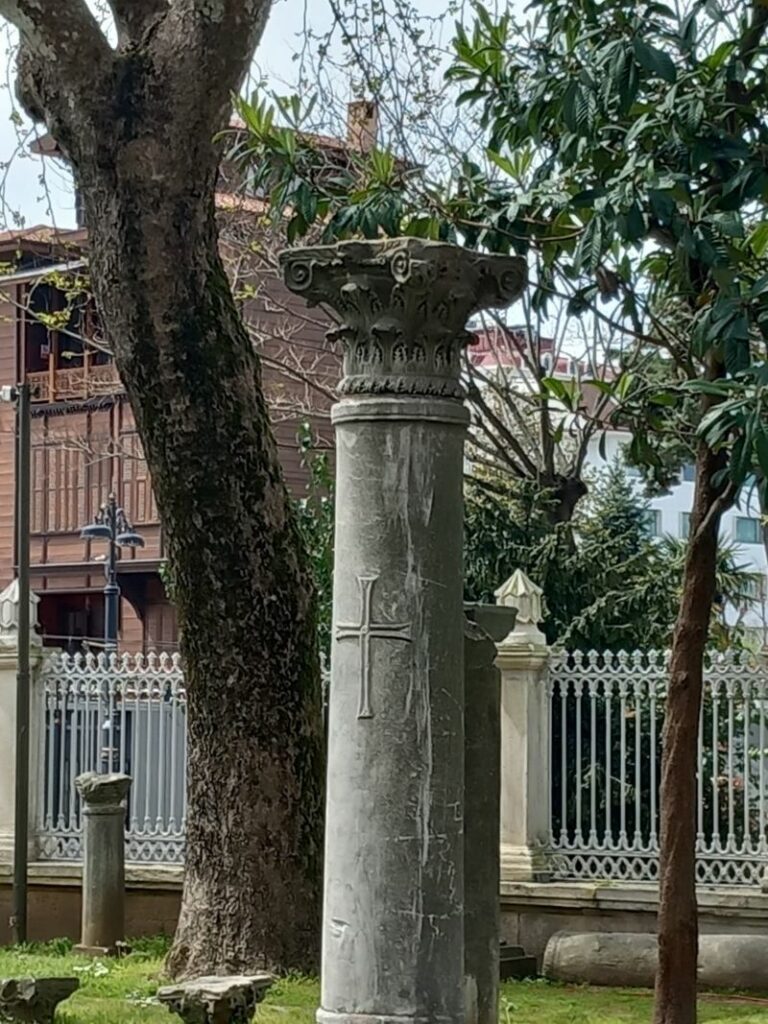
Multiple columns with crosses stand as garden ornaments on the grass. Also, a few capitals lie on the ground, decorated with crosses. When these Ionic capital columns lie on the ground near an important Türkiye site, this means they were found nearby. The Byzantines used columns as interior decoration and externally to form important entry/walkways and courtyards. These in the garden testify to the outward display of Christianity when one approached the church in past generations. They did not hide the importance of the cross.
Therefore, they represent an essential historical declaration of Christian purpose. How many crosses can you spot?
Sacred items in Hagia Sophia’s Courtyard
Today’s courtyard and garden space formerly housed the elaborate Hagia Sophia Atrium. This Atrium stood on the West side of the church, which showed the importance for worshipers to proceed East for worship. Byzantine Legacy said, “The most important loss is the disappearance of the Justinianic Atrium that preceded the church on the West. The Atrium extended westwards from the outer narthex for about 42 m and its three sides opened into the courtyard through pairs of columns alternating with piers. In the centre of the Atrium was an elaborated marble fountain.”[1]https://www.thebyzantinelegacy.com/hagia-sophia So, these columns that we see before us give insight into the beauty of this former square.
Other historians mention the numerous washing fountains and spouts featuring carved animals.[2]https://hagiasophiaturkey.com/the-fountain/ One historian mentions the beauty of twelve lion heads spouting water.[3]Descr. S. Sophiae, vv. 594 ff (ed. P. Friedlander, Johannes von Gaza und Paulus Silentiarius (Leipzig and Berlin, 1912), 103. On https://www.thebyzantinelegacy.com/polyeuktos one of the pictures … Continue reading Much like Byzantine baptism, where they entered from the West and exited on the East, the Atrium featured places for the believers to enter with clean hands, faces, and hopefully hearts to enter the church from the western Atrium.
These capitals and pillars display hidden crosses in the Hagia Sophia’s courtyard, which give witness to the cross and enable worshipers to turn to Christ’s sacrificial death.
The Pulpit in the Hagia Sophia’s Courtyard
The former inside marble pulpit (called Ambo from the Greek) lies near the fence, and the marble-laden crosses focus the observer that they are “crucified with Christ” (Galatians 2:20). A minister most likely entered on one staircase and exited on the other. Spiritual servants offered Scripture readings, prayers, and sermons from the elevated platform. This pulpit from a former Beyazit Byzantine church (Theotokos of Diakonissa) near the cover bazaar sat most likely within the church in an East/West orientation just below the central dome. The speaker faced south to speak to the people. Observing the condition of the pulpit, the podium was dragged out of the church and left in ruin. Now repaired without any label sits in the courtyard, eliciting silence.
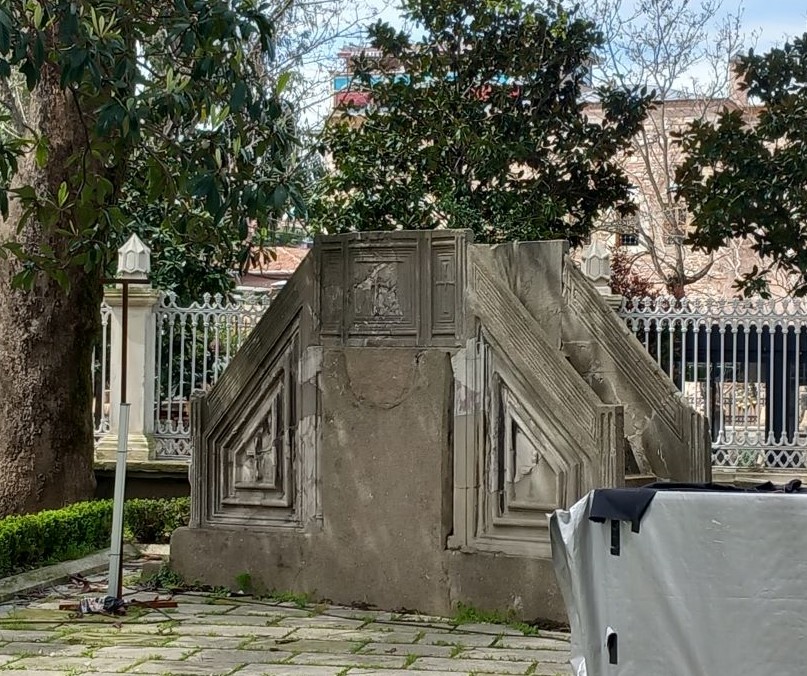
Grave Remains in the Hagia Sophia’s Courtyard
The church also had many royal and religious graves on the property or nearby. Over a hundred years ago, renovations revealed from underground some of the Royal Byzantine porphyry tombs of Justinian’s time near St. Irene and Topkapi Palace.[4]https://www.pallasweb.com/deesis/imperial-porphyry-tombs.html – provides some pictures of these discoveries. Yet in this courtyard and also, an inside corridor remain multiple Byzantine empty tombs. The rock grave’s simple markings of carved crosses remind Christians to bear the cross, a hope depicting Christ’s death and resurrection.
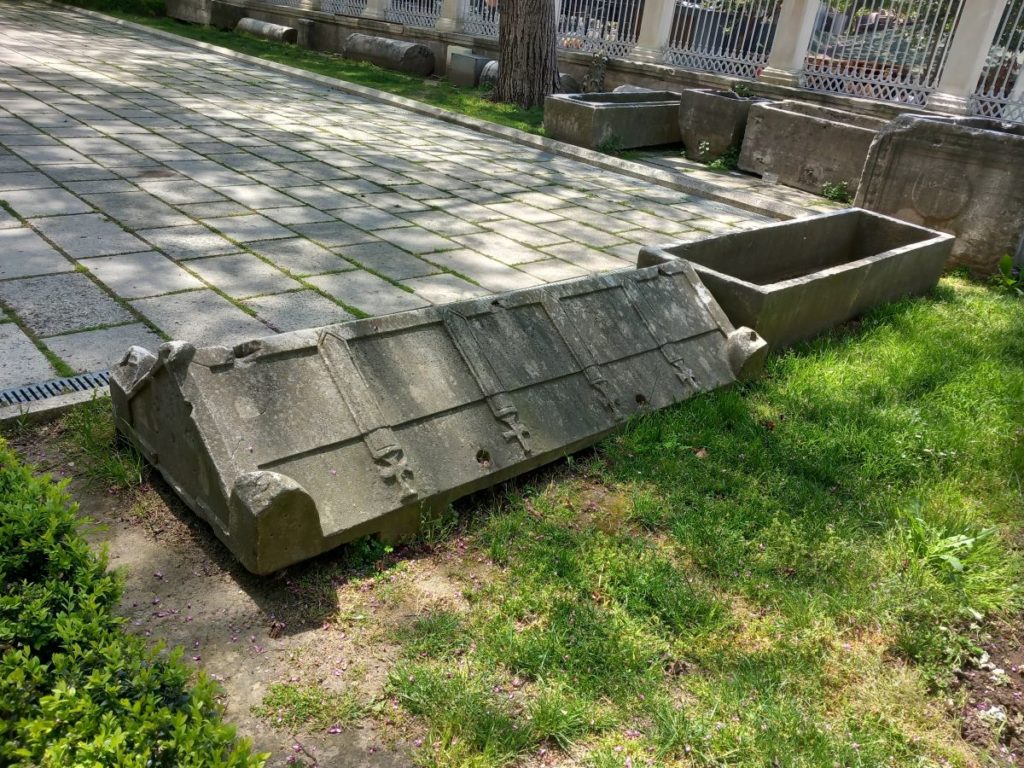
However, today, no remains or honor remains like the 50 or more Ottoman tombs on the southeastern side of the church; just discernible crosses are smeared on empty tombs. They represent a shell of past Byzantine glory and a hidden story of discretion.
Exterior Crosses of Hagia Sophia
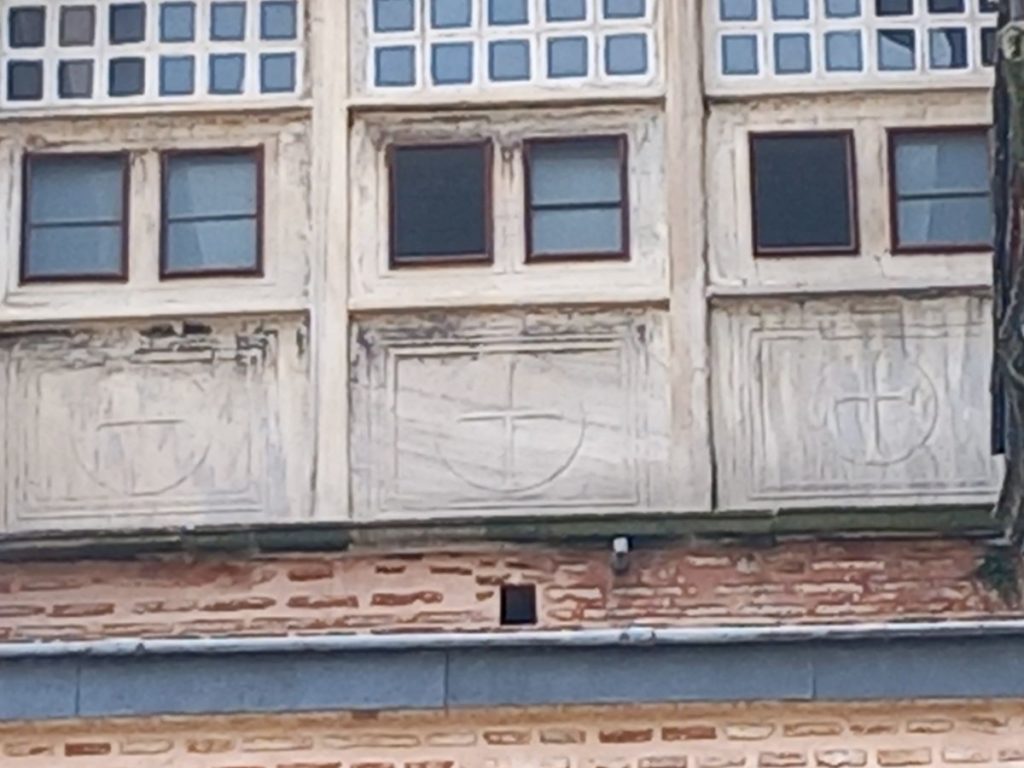
First, before entering the building, look up from the entrance between the two massive. The archways display hidden crosses on the marble below the windows. The pattern encompasses the building, exhibiting the cross’s priority in testifying to those entering the religious sanctum.
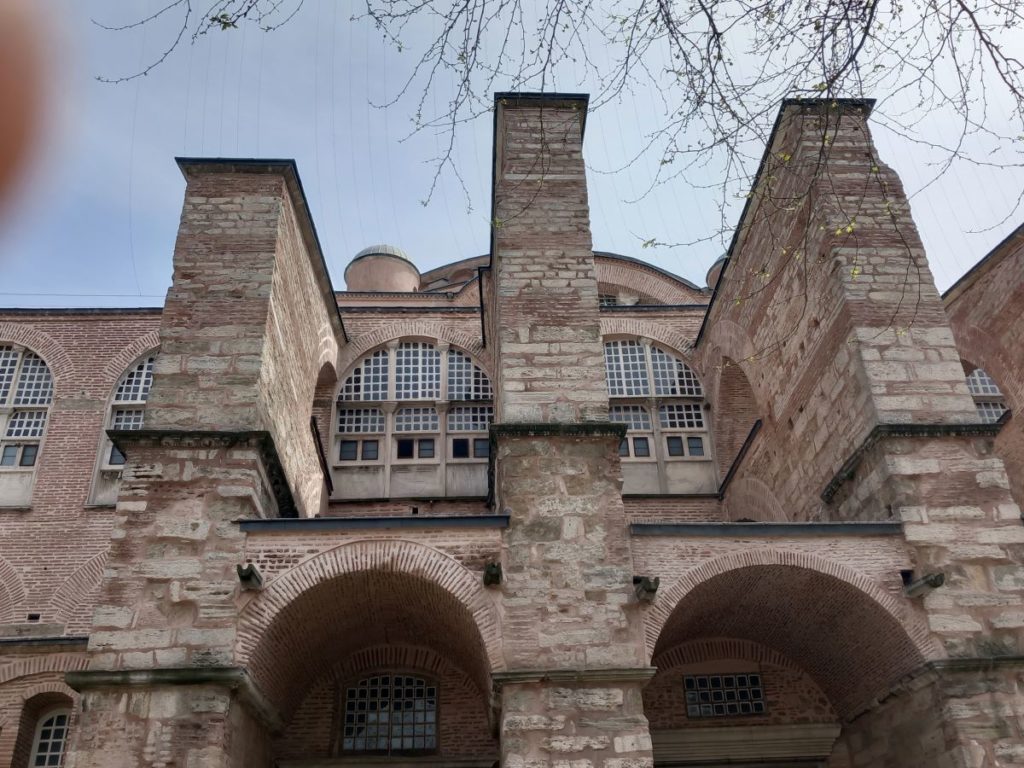
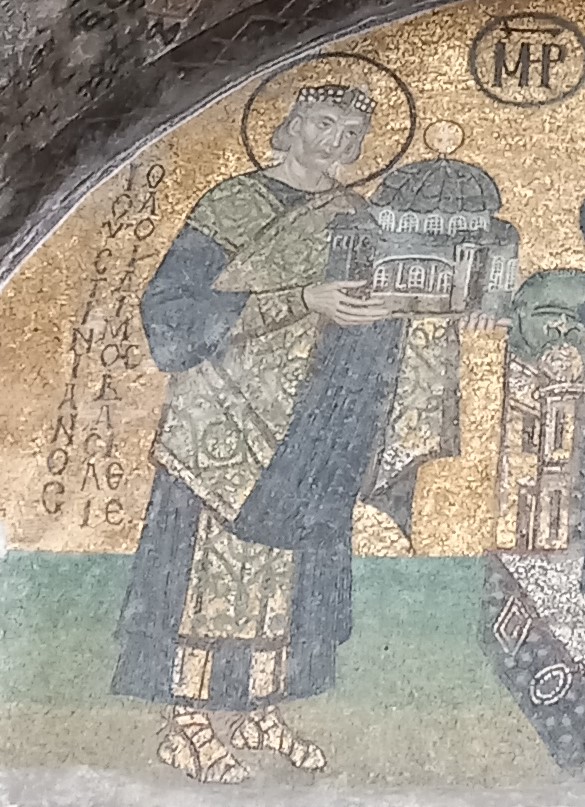
The dome’s exterior had a cross in Justinian’s mosaic at the exit. If the original had a cross, the second dome had none or less of one to sustain the weight. So that the new dome of 559 A.D. would not collapse to extra weight again. For the Byzantines, even the exterior presented the focus of the gospel.[5]a fascinating discussion on this topic exists on https://history.stackexchange.com/questions/56734/what-happened-to-the-cross-on-the-dome-of-hagia-sophia. Unfortunately, history does not give us a clear guide on this hidden cross.
Remains of the Second Hagia Sophia
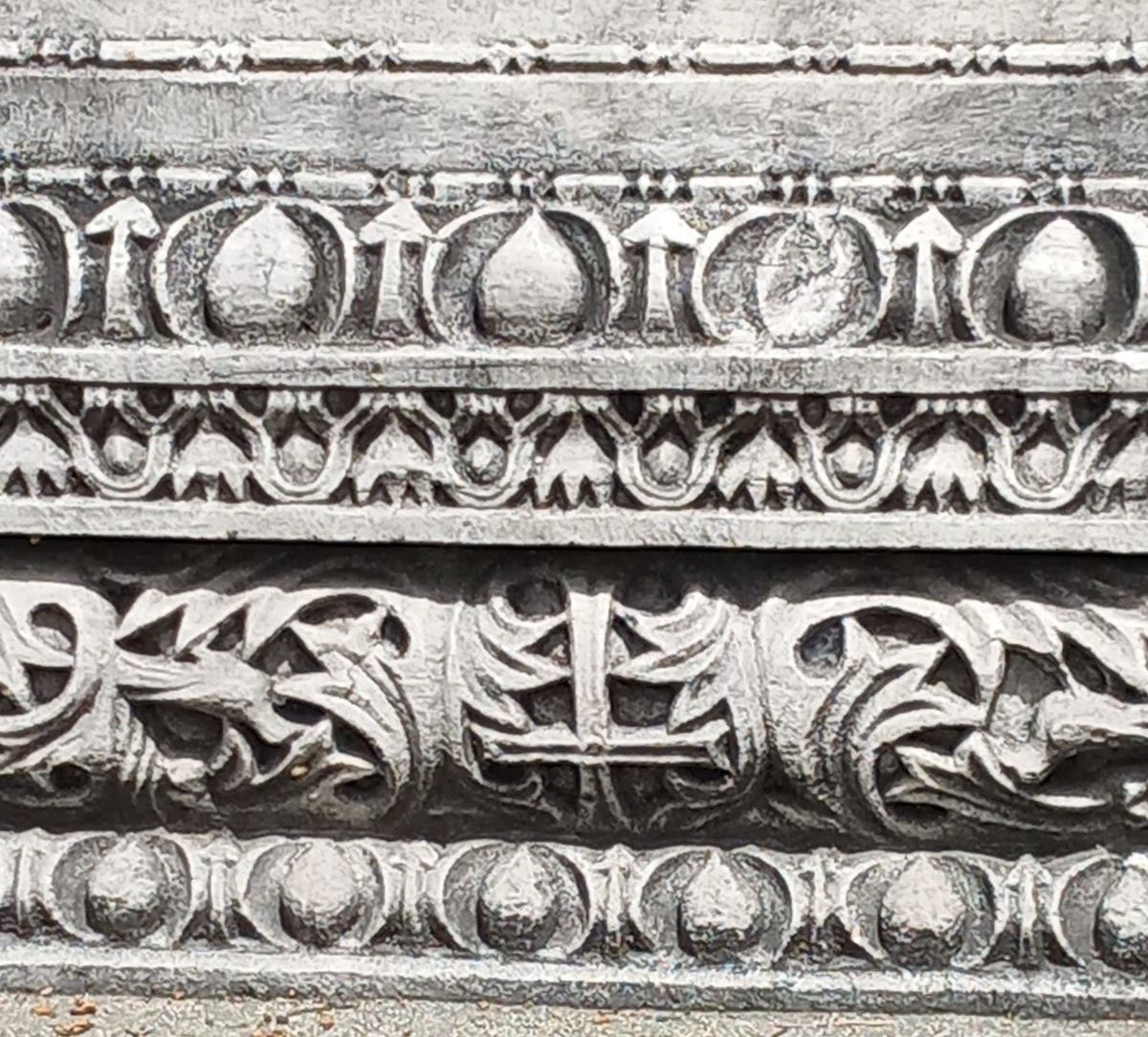
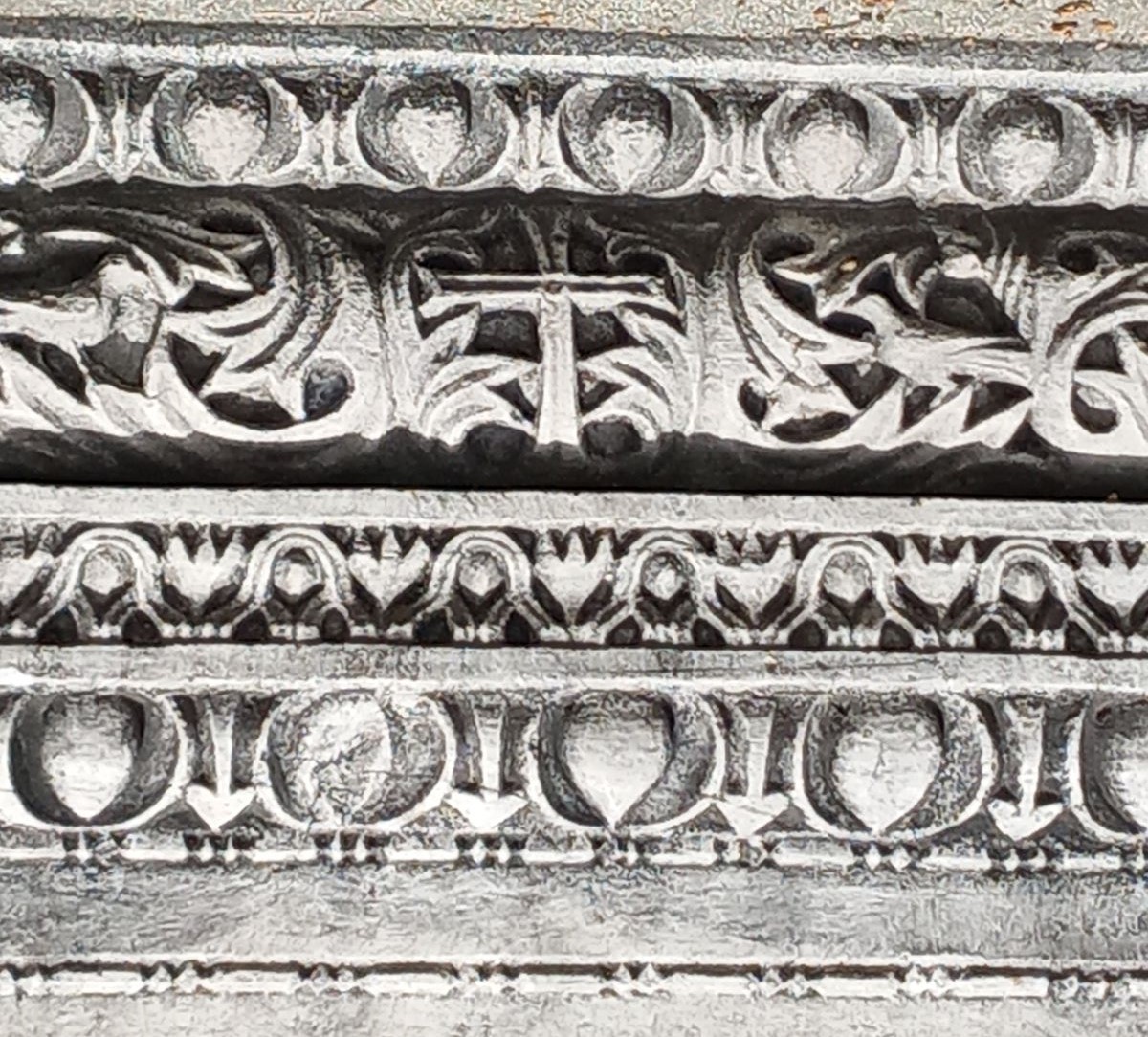
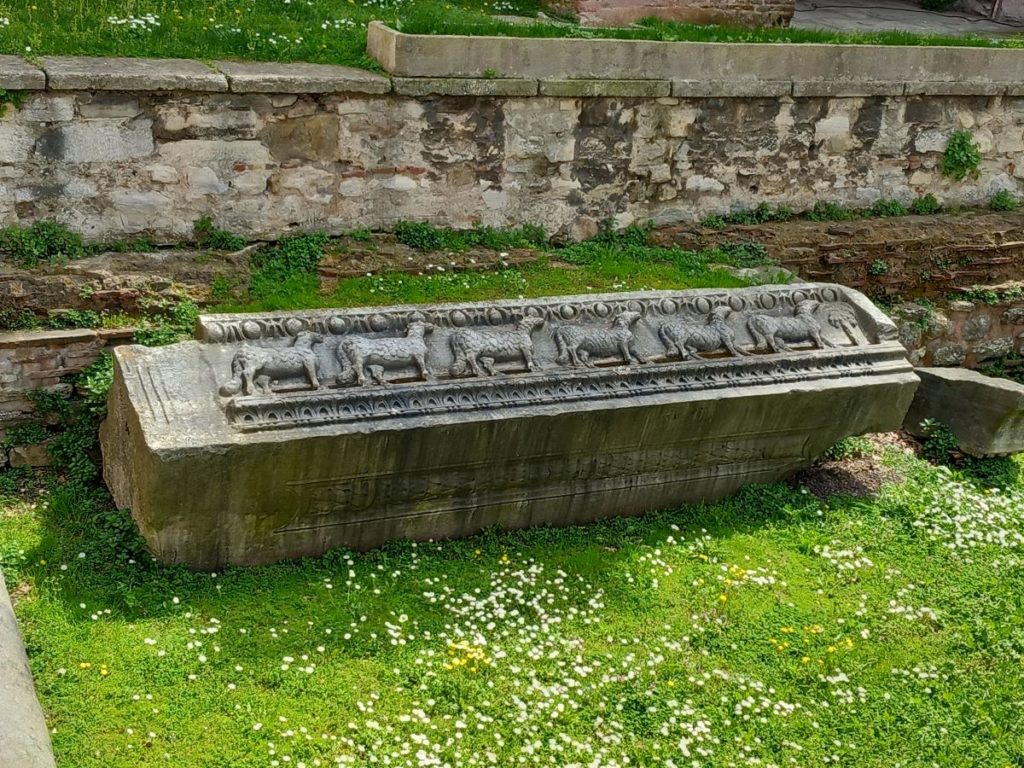
Many of the remains of the second building lay in the courtyard/lawn between the cafe and laboratories. The picture above offers the upside-down courtyard version of the rock-carved panel (left) and how the panel existed on the former church building (right).
Before entering the building, the lower level on the left displays this church’s foundation (pic). The portion of a two-part sheep-carved panel reminds the observer of the Lord Jesus as the good shepherd. Twelve sheep representing the apostles hint at the mastery of the former building. The partially wooden structure burned in a riot in 404 AD, encouraging Justinian to make his new church out of rock and brick.
Musing on Historical Narrative
Before I married, I lived in Istanbul and attended the night lighting and presentation of the Blue Mosque. I do not know if they still do this, but the crowd sat with our backs to Hagia Sophia. The light show highlighted the mosque and the “glories” of the building. As the show moved forward, they darkened the Hagia Sophia and honored a building made over 1,000 years later. Likewise, the tramway stop states Sultanahmet to give priority to Muslim history. I felt cheated and bewildered by the perspective presented; something was amiss.
Not desiring to ignore history, I wanted to learn from observation. I think of Al-Ghazali’s words, the Muslim scholar, “Whoever determines the truth from people alone will remain lost in the plains of bewilderment. Rather know the truth and you will know its people.” The community agenda sometimes bewilders, and blindly accepting Christian remains in a courtyard as valueless brings no benefit. Yet, the historical truth cannot remain hidden, especially about this unique former church called Hagia Sophia.
Islamic history consistently begins with submission, entailing those conquered will only share the dominant narrative. Islamic belief is based on their belief about God, much of which I explain in my book, Searching Below the Surface. However, biblical history differs in showing God’s plan from the beginning, which enfolds within each culture and penetrates different worldviews. God’s history desires to incarnate rather than only seek domination. His love for Asia Minor, Bithynia, and modern-day Türkiye shines dimly yet consistently in these ancient Christian artifacts. What was, and is still bears witness to God’s goodness to this land in understanding Byzantine history.
References
| ↑1 | https://www.thebyzantinelegacy.com/hagia-sophia |
|---|---|
| ↑2 | https://hagiasophiaturkey.com/the-fountain/ |
| ↑3 | Descr. S. Sophiae, vv. 594 ff (ed. P. Friedlander, Johannes von Gaza und Paulus Silentiarius (Leipzig and Berlin, 1912), 103. On https://www.thebyzantinelegacy.com/polyeuktos one of the pictures shows a lion head spout. |
| ↑4 | https://www.pallasweb.com/deesis/imperial-porphyry-tombs.html – provides some pictures of these discoveries. |
| ↑5 | a fascinating discussion on this topic exists on https://history.stackexchange.com/questions/56734/what-happened-to-the-cross-on-the-dome-of-hagia-sophia. |
[…] The Shunned Hidden Crosses in the Hagia Sophia’s Courtyard […]